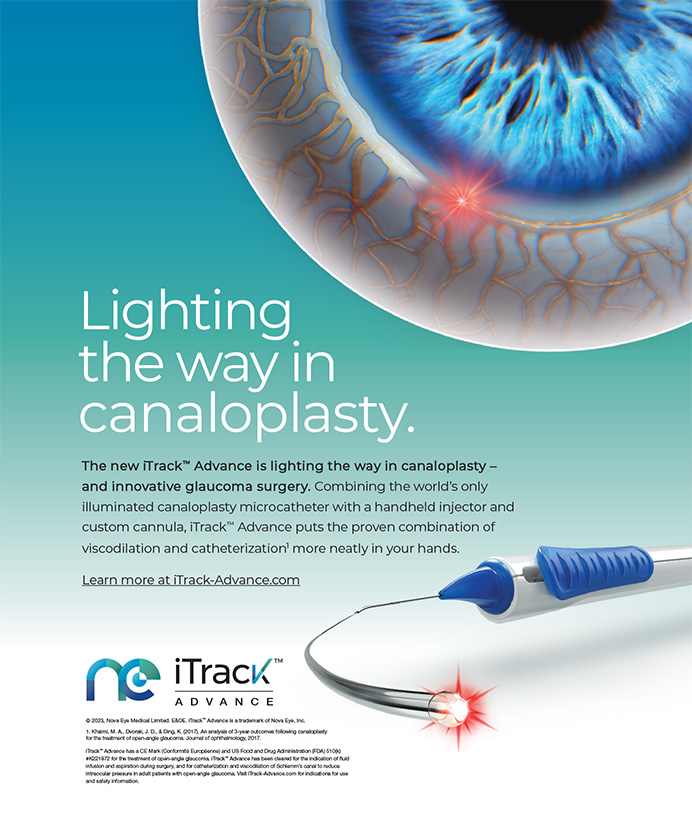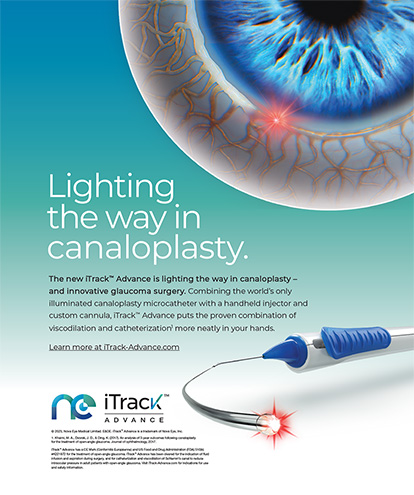An anterior capsulotomy is the capsular incision necessary to permit removal of the nucleus and cortex. It should be capable of preserving the integrity of the capsular bag against the asymmetric forces that occur during phacoemulsification and IOL implantation. By maintaining symmetry of the capsular bag after IOL implantation, the anterior capsulotomy should confine the haptics and prevent IOL subluxation due to delayed contractile forces. The continuous curvilinear capsulorhexis, developed concurrently by Drs. Gimbel and Neuhann in 1986,1 was a landmark advance because it achieved both of these goals. It has led to safer phacoemulsification and to improved postoperative IOL centration.
The anterior capsule is a homogeneous basement membrane that is made up of collagen-like protein. It has elastic properties without being composed of elastic fibers. The underlying epithelial cells are loosely adherent. Finally, the anterior capsule has a smooth surface contour except at the equator, where the zonules attach. These properties of the anterior capsule allow a multidirectional continuous curvilinear capsulorhexis to occur. However, these same characteristics can lead to misdirected and errant tears.
THE TEAR DILEMMA
A smaller diameter capsulorhexis is easier to control than a larger one. For most patients, a capsulorhexis diameter measuring 0.5 mm to 1 mm smaller than the IOL optic diameter is preferred. The IOL generally remains well centered postoperatively in this situation. However, in eyes that have weakened zonules or an excessively hardened nucleus, it is preferable to have a capsulorhexis diameter that is 0.5 mm to 1 mm larger than the optic. This will allow for cataract removal techniques that minimize stress to the already weakened zonules. As the capsule contracts postoperatively, the IOL will remain centered. Avoid making a capsulorhexis that matches the optic diameter because the IOL can ?pea pod? off-center as the capsulorhexis and capsular bag contract postoperatively.
ASSESS ZONULE STRENGTH
How does the surgeon know if the zonules are weak at the onset of the capsulorhexis? It is necessary to execute a “zonular strength assessment” every time a capsulorhexis is performed. The surgeon, with whatever instrument is used to initiate the capsular puncture, should “jiggle” the lens diaphragm slightly to determine zonular strength. If the zonules appear strong, then the capsulorhexis can be the standard size of 0.5 mm to 1 mm smaller than the optic diameter. If the assessment shows a generally loose lens diaphragm, then the capsulorhexis should be 0.5 mm to 1 mm larger than the optic. Finally, if the zonular strength assessment shows an asymmetric weakness, the rhexis should still be 0.5 mm to 1 mm larger than the optic, but placed off-center and away from the possible dehiscence. The IOL optic will better align and center up with the capsulorhexis when the haptic is oriented toward the quadrant of zonular weakness.
Why is a larger diameter capsulorhexis more difficult to control? The primary reason is that the anterior capsular contour slopes away more dramatically from the surgeon's instrument as one moves toward the periphery. As it spirals peripherally, the capsulorhexis tear can suddenly encounter a zonular attachment that can act as a straight edge, sending the tear out to the capsular fornix and possibly around and through the posterior capsule.
Once an errant tear starts to extend radially, the surgeon should appreciate that it becomes much harder to control as the tear approaches the periphery. This is because the anterior capsular dome, and thus the base of the tear, drops away from the tip of the tool (forceps) that is controlling it. This is much like giving a dog too much lead on its leash. One cannot control the errant dog or the errant tear when there is too much “leash” ahead of one's grip. Understanding this principle that errant tears run “downhill” and away from the forceps tips dictates the following preventive measures:
1. Avoid lifting the capsular flap during the capsulorhexis.2. Keep the capsule forceps low to the anterior lens surface and forward to the base of the tear.
3. Lead the tear much like one pulls a wagon in a circle by its handle. Think of the tearing motion as being more of a ?peeling? action.
4. Utilize capsulorhexis forceps, such as the Connor Peeler (Rhein Medical, Tampa, FL), that have forward facing tips. Tips with this orientation facilitate a peeling action, rather than the lifting motion that downward facing forceps tips promote.
5. Regrasp frequently—at least at every quarter hour of circumference—to optimize control of the base of the flap.
THE DOWNHILL CHALLENGE
A lifting movement can cause the base of the tear to advance downhill and out toward the periphery. Certain patients present with what I would call a “downhill challenge.” These eyes have an unusually steep anterior capsular dome that predisposes them to having an errant capsulorhexis tear occur. Children, young adults, and hyperopes fall into this category. A swollen, intumescent lens, or eyes with posterior pressure will be a challenge for the same reason, namely, the presence of a steep anterior capsular dome.
A steeper anterior lens curvature produces an unwanted effect similar to that of lifting the flap upward. The base of the tear runs downhill and away from the point of control. By anticipating this lens configuration, one can negate the downhill slope of the dome. I call this a ?touchdown? maneuver. The surgeon employs the fellow hand to flatten the steep anterior lens dome as the capsulorhexis is being performed. A blunt-tipped instrument, such as a Connor Wand manipulator (Rhein Medical), is used to depress the central lens surface just under the initiated capsulorhexis flap. This reverses the chamber shallowing caused by posterior pressure and helps flatten the anterior lens dome. The capsulorhexis is then completed around this centrally placed tool (Figure 1).
THE MIGRATING CAPSULORHEXIS TEAR
Suppose the surgeon has followed the previously mentioned precautions, and the capsulorhexis tear still wants to migrate peripherally? First, he or she should deepen the anterior chamber with a cohesive viscoelastic. Next, I suggest maneuvering the errant flap into a peeling orientation. Tilt the eye to grasp the flap at its base and from a forward position. If the misdirected tear does not turn around, employ a touchdown maneuver with the fellow hand. This technique of depressing the central lens surface with a wand manipulator to counter posterior pressure and flatten the anterior capsule contour will often allow the recovery of an errant capsulorhexis.
Tilting the eye enables the surgeon to better control the base of the flap by utilizing a forward peeling position. If an errant tear cannot be “rescued,” do not try to reinitiate the capsulorhexis with a new tear proceeding in the opposite direction. This will produce a teardrop-shaped capsulotomy, in which the iris conceals the full extent of the radial tear. During phacoemulsification, this capsulorhexis “split” could very well extend around the capsular fornix and through the posterior capsule, which could possibly result in a dropped nucleus. Instead, use a cystotome to offset the forces transmitted to this weakened area by making numerous relaxing incisions in the capsule for 90º. These multiple puncture incisions should begin adjacent to the radial tear and as far out as one can visualize. After one quarter hour, or 90º, regrasp the capsule and finish the rhexis. The capsular bag will be able to sustain the forces necessary to remove the cataract and still allow the surgeon to knowingly insert the IOL within the bag.
If the surgeon inadvertently cuts the intact capsulorhexis rim during phacoemulsification, he or she should immediately stop and refill the anterior chamber with a thick, cohesive viscoelastic. I recommend using fine-tipped scissors to make two additional relaxing incisions in the capsulorhexis approximately 120º away from the accidental tear. Elevate the nucleus out of the capsular bag by injecting either fluid or viscoelastic. Finally, sandwich the nucleus with viscoelastic and complete the emulsification at the iris plane. The surgeon can still place the IOL within the salvaged capsular bag (Figure 2).
ADDITIONAL STRATEGIES
The “touchdown” technique to counteract a steep anterior capsular dome may not be possible in children, or with an intumescent lens, because the nucleus is too soft. There may not be enough resistance for the wand to depress against in order to flatten the anterior lens surface. To avoid an errant tear from occurring in these situations, the surgeon can employ a two-stage capsulorhexis technique. The initial capsulorhexis should be kept central and small, about 3 mm in diameter. Use an I/A tip to remove anterior cortex and decompress the lens. Then refill the anterior chamber with viscoelastic and incise the smaller diameter capsulorhexis rim with either scissors or a cystotome. Enlarge the capsulorhexis to the standard 5.0 mm to 5.5 mm size before completing phacoemulsification.
Finally, if a posterior capsular rent occurs during phacoemulsification, whether centrally or as a result of a radiating anterior capsular cut, employ the same principles as mentioned previously. Remember that because tears always run downhill, make the posterior capsule concave with a thick, cohesive viscoelastic before attempting a posterior capsulorhexis with long-tipped forceps. Perform this step as soon as the posterior capsule defect is recognized and before continuing with phacoemulsification, cortex removal, or lens implantation. Completing a posterior capsulorhexis salvages the integrity and strength of the capsular bag, permitting in-the-bag implantation of an IOL.
Christopher S. Connor, MD, is Assistant Professor at Dartmouth Medical School, Hanover, NH, and the Director of Clinical Services for the Dartmouth-Hitchcock Medical Center. He holds a financial interest in the Connor Wand and the Connor Peeler. Dr. Connor may be reached at (603) 650-5123; Christopher.S.Connor@Hitchcock.ORG1. Gimbel HV, Neuhann T: Development, advantages, and methods of the continuous circular capsulorhexis technique. J Cataract Refract Surg 16:31-37, 1990


